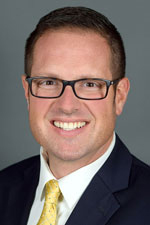By CHRIS JENSEN
Noblesville Mayor
 When I took office in January of 2020, our team promised big plans to move our city forward while protecting and enhancing our downtown core. Because we are such a desirable place to live, Noblesville is growing at a rapid pace, which creates infrastructure and public services challenges that must be addressed.
When I took office in January of 2020, our team promised big plans to move our city forward while protecting and enhancing our downtown core. Because we are such a desirable place to live, Noblesville is growing at a rapid pace, which creates infrastructure and public services challenges that must be addressed.
In my previous roles, I had the privilege of traveling all over the Hoosier state. I observed how cities and towns were either growing and proactively meeting the needs associated with growth or becoming stagnant and complacent. It was clear to me which locations had invested in themselves. They had solid infrastructure plans designed to address current and future community needs, forward-thinking public safety professionals, and art and recreation features that gave life to their downtown core and personality to their public spaces. There were trails connecting residents from one side of the city to another.
These enhancements are no longer viewed as a perk of a community, but instead have come to be an expectation by its residents. People expect access to a high-quality trail network and other public amenities. Public art makes a community come alive and drives tourism. Modern infrastructure keeps travelers safe and helps get families where they need to go.
Although 2020 did not go as anyone had planned, our administration took a calculated risk and bet on Noblesville. We continued our plans of strategic development, and we moved the Reimagine Pleasant Street, and several other infrastructure projects, forward. Throughout this process, we focused on balancing our efforts to address growth challenges against available resources and the impact on local residents and businesses. As we move out of those uncertain times, I am proud that we invested in our community and demonstrated just how resilient Noblesville is.
Plans for expanding Pleasant Street have been talked about before I was born, and the first official study for east-west mobility in our city began in 1987. These studies continued for years and were passed along from one administration to the next. I refuse to pass this project along to the next administration. Since the first studies were completed in the ’80s, our city’s population has increased five-fold.
I knew that this administration, in good conscience, could not ignore the need for east to west connectivity. This has been compounded by our rapid population growth, which is projected to continue to grow significantly in the next few decades. Furthermore, I was insistent that we study any and all alternatives for the current route.
In the end, state and federal agencies confirmed our current route as the best alternative providing the most traffic relief while also balancing environmental, economic, and personal impacts.
More than 100 resident, business and public meetings were held by our administration alone. One of our main goals was limiting the impact on existing homes and businesses. With such a large road project going through an established part of our town, some impact was unavoidable. Once the route was approved and finalized, we were in regular communication with the affected owners to explain the timeline and how we would perform the property acquisition, utility relocation, drainage, and construction work in a way that accommodated their preferences while adhering to legal requirements and keeping the project on track.
The Reimagine Pleasant Street Project has been researched, studied, and evaluated for decades. This project is not easy; we knew that from the beginning. At times it has been emotional, for businesses, residents, and for me and my team. We know just how important and needed this new east-to-west connection will be.
Aside from the traffic improvements, the Pleasant Street project will also complete a key trail network connection in our city, linking the Riverwalk Trail, Midland Trace Trail, and Nickel Plate Trail. This network will enhance pedestrian and bicycle connectivity through the heart of our downtown and link directly to many neighborhoods.
On Tuesday of this week, our Board of Works received six bids for Phase One of the Pleasant Street Project. Two of these bids were below the projected cost of what our engineers estimated for Phase One of the project, which is extremely rare in this current construction market. To have all bids come within 5 percent of the estimated cost of a project shows that we have a solid set of plans, and the project development has been executed well.
One study estimates that this project it will generate a total economic impact of $1.6 billion, support over 7,000 new jobs, and generate nearly $185 million in local, state, and federal tax revenue. This economic value will benefit all our residents and keep our community vibrant for decades to come while preserving our uniqueness and authenticity.
To learn more about the Reimagine Pleasant Street project, including how the route was selected, public involvement, funding, and preferred route studies, visit ReimaginePleasantSt.com.
I look forward to continuing to engage with the community on this important project as we invest in Noblesville’s future.
Chris Jensen, a Republican, serves as the Mayor of Noblesville.
